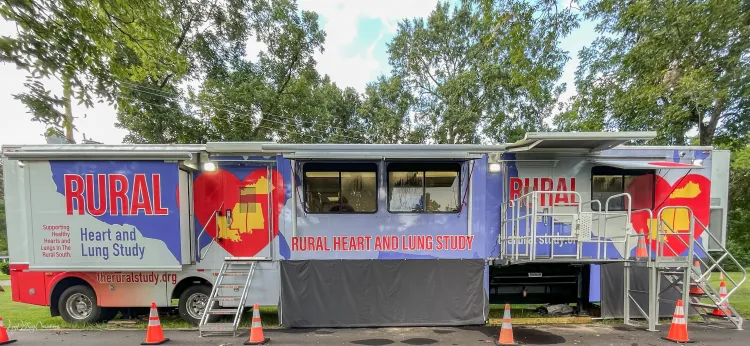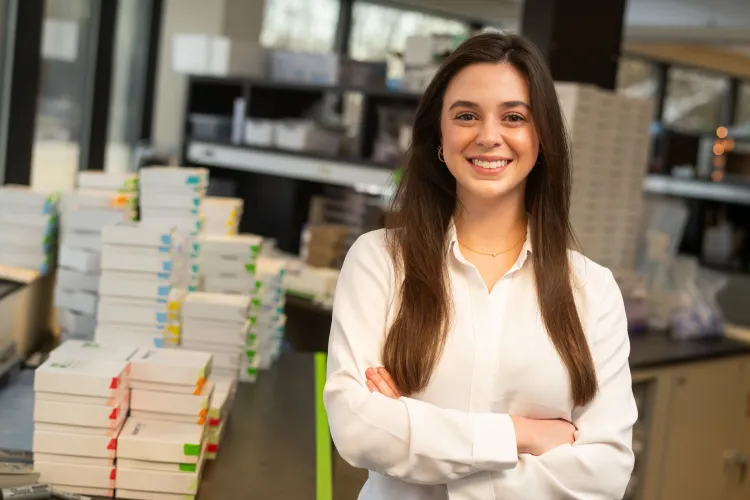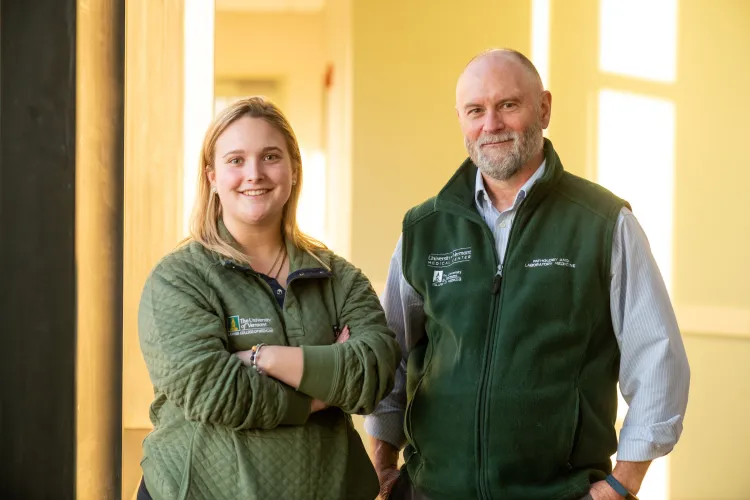In a tractor trailer in Mississippi, vials of urine and blood are color-coded with stickers and packed on ice bricks in a Styrofoam-lined box before a 1,100-mile flight to the University of Vermont’s research facility in Colchester.
There, April Perry demonstrates how a team of other technicians catalog the samples and organize the red blood cells, plasma, urine, and serums into batches for lab testing. Perry pulls on a lab coat and pair of blue latex gloves before opening a sub-80-degree Celsius freezer. She removes a metal tower filled with boxes containing tiny plastic cryovials. Samples are meticulously organized so that nothing is lost or wasted. It’s a fiddly process during which Perry’s fingers sometimes go numb.
The vials quietly tink tink in the relative warmth outside the freezer. A coating of hoarfrost grows on the metal tower while Perry checks the humidity level of a bag of dried blood spot cards. She needs to process one more shipment before sending the samples to long-term storage at the university’s freezer farm—an indoor tundra of 180 sub-80 freezers holding more than 6 million samples from some of the longest running cohort studies in medicine, including the Multi-Ethnic Study of Atherosclerosis, the Jackson Heart health Study, the REasons for Geographic And Racial Differences in Stroke Study, and now, the Risk Underlying Rural Areas Longitudinal (RURAL) Study.
“We are the biorepository for all of those studies,” explains J. Peter Durda, '80 Ph.D.'17, a research scientist in UVM's Laboratory for Clinical Biochemistry Research and lead RURAL researcher.
The project is a six-year, $21.4 million study funded by the National Institutes of Health, that spans four states and 16 institutions, including UVM, and is designed to uncover potential risk and protective factors for individuals in the rural South where the prevalence of lung and heart disease is among the highest in the country. The study focuses on lung, heart, blood, and sleep measures and aims to recruit about 4,600 multi-ethnic participants from 10 counties in Alabama, Kentucky, Louisiana, and Mississippi.
“There are so many moving pieces and the primary piece in any of these studies is the participants,” Durda says. “Because if you don’t have them, you don’t have a good study.”
Studying the unstudied
Historically, rural residents have been under-represented in studies because of their distance from research institutions. The RURAL study is different. It brings the lab to rural residents using a mobile exam unit (MEU).
“Technology has led us to this place where we no longer need the brick-and-mortar to invite participants to come to the bigger city, and instead of asking it of them, we can meet them where they are,” explains Megan Evans, manager of the MEU. “A study like this hasn’t really been done before.”
Inside the MEU, participants undergo a battery of exams from CT scans, echocardiograms, lung and circulation tests, and complete numerous health surveys. This baseline visit takes about three hours.
“There is so much you want to know but you have to be cognizant of the burden on the people,” Durda explains. “You want them to be happy, you want them to come back. You want them to feel like they are part of something. That’s an important piece of any cohort study is retention.”
Part of the study’s pitch to participants is not just the data they provide to scientists but the personal health information that they get back. Participants receive Fitbits to track their steps and sleep metrics as well as results from the CT scans, imaging, and bloodwork taken while aboard the unit.
“If they were getting all of this done at a hospital it would take about a week,” says Evans.
She travels with the MEU to study sites every three months and runs its daily operations. Her job is to make onboarding participants and data collection a friendly and efficient process.
“Because this is a study over time, we want folks to be as happy as possible and stay in as long as they want to,” Evans explains. “I want to make sure that people feel heard and supported.”

The RURAL Study brings the lab directly to rural communities using a mobile exam unit where participants undergo a battery of exams from CT scans, echocardiograms, lung and circulation tests, and complete numerous health surveys.
Over the course of RURAL, participants track their movement and sleep and complete additional surveys using a mobile app. While the reasons people choose to participate vary for everyone, Evans has seen some themes emerge. Some RURAL participants join for the free health testing.
“I think another motivator for folks is family history,” she says. They want to be the generational change. They are like ‘my mom had diabetes, dad had diabetes, I now have diabetes, or my dad has this genetic disorder and I want to see if I have it,’ because we do genetic testing, too.”
Recruitment for each county uses community health workers—people who have established relationships or who can build trust with individuals in the study areas. And the trust factor has made the difference. The study has made steady progress reaching recruitment targets in the counties visited so far.
“A common misconception about the study is that it is a study for the poor,” Evans says. “It is not. You just have to be a rural resident in one of the counties in the study between the ages of 25-64. We see all walks of life, with [health] insurance and without it, from various incomes.”
Lily Felten, a junior biological sciences major at UVM, learned about RURAL the old-fashioned way—through a news clipping her grandmother sent from Starkville, Mississippi where the MEU was stationed this summer.
“[She] knew that I have done some research on infant mortality rates in Mississippi and areas in the delta and the great disparities there, and said ‘maybe you should contact them,’” Felten recalls.
Her query landed her an internship on the MEU in Starkville. Felten helped set up Fitbits and phones for participants, reviewed consent forms with them, collected blood circulation data, and shepherded people through the many health surveys.
She knows major findings from the RURAL study are years away, but Felten is excited about what it means for communities in the rural South, where her family has deep ties. The free health exams are one thing, she says, but when “you think about major health studies that have occurred like the Framingham Heart Study, that information will be tailored to that area. … [Researchers] are already starting to look at data—and even that little bit will tell us so much about what’s happening in that little area and give us a starting base to serve these communities.”

Lily Felten, a junior biological sciences major, interned on the mobile exam unit in Starkville, Mississippi last summer where she assisted with data collection. Photo by Andy Duback.
Her interest in studying health disparities blossomed in an honors course in her sophomore year and further developed through a Shepherd Higher Education Consortium on Poverty internship in Louisville, Kentucky. Felten worked in a medical case worker’s office for Kentucky Refugee Ministries, shuttling clients between doctor’s appointments.
“You could really tell the ones—the really good providers—that knew about and really respected the social determinants of health,” she says. “Seeing the difference in the outcomes of those clients was when it really started to click for me.”
But it was while Felten was standing on the MEU in Mississippi, preparing packages of blood samples to drop off at the UPS store that she realized she had another connection to RURAL—through UVM, where the vials were being sent.
Mentoring the next generation
UVM leads the biorepository and assay core for RURAL, which is responsible for collecting and processing biological samples, analyzing them for cardiovascular biomarkers, and storing the samples for future research. UVM was selected for the role because of its longstanding expertise in blood analysis. This is largely due to the work of Russell Tracy, University Distinguished Professor of Pathology and Laboratory Medicine and Biochemistry and a co-PI on RURAL.
He directs UVM’s Laboratory for Clinical Biochemistry Research and developed the program after joining the faculty in 1984. At the time, Tracy had one technician and a goal of producing research assays at the level of clinical assays.
“Implementing rigorous quality control and making sure things are reproduceable … wasn’t yet a built-in concept in biochemistry,” he says. “That is what I was trying to do.”
Tracy’s team ballooned during a large clinical trial where they served as the blood core, which snowballed the lab’s involvement in projects like the Cardiovascular Health Study (CHS). This work put UVM’s expertise in blood on the map. Over the decades, the university’s biorepository has become invaluable for longitudinal health studies today.
“Our mission is to improve the health of the people of the United States,” Tracy recalls frequently telling his lab members. “That is our mission.”
And he means it. Tracy is proud of the work their team has done on heart disease, HIV, and now, with RURAL. And it’s a mission Durda recites separately (and without prompting.)
“Hopefully, RURAL will do this and our contribution along with that of the many other RURAL investigators may play a small part,” he says. “As an added benefit we at UVM have been able to bring along a new generation of researchers.”

Maggie King (left) has worked with J. Peter Durda (right) on two research abstracts using data from the RURAL Study. Last spring she presented on the validity of a blood analyzer used on the MEU at a meeting of the American Heart Association. Photo by Andy Duback.
Durda is a veteran of Tracy’s lab and who has long studied biomarkers in blood and what they can reveal about the health of a person and the potential risks they face. A blood sample can show glucose levels and flag individuals with diabetes. Triglycerides and cholesterol numbers can be indicators for atherosclerosis—hardening of the arteries—and heart disease. High levels of an inflammatory marker called C-reactive protein may suggest a more serious health condition.
Durda is increasingly interested in exploring the social determinants of health. These are the life experiences and conditions that affect a person’s health outcomes such as their education level and economic status, access to healthcare, exposures to pollutants, and neighborhood factors such as distance to grocery stores and housing security.
He and Maggie King, a master’s student in pathology and laboratory medicine, are working on an abstract with RURAL researchers testing associations between housing instability and indicators of cardiac disease, such as coronary artery calcium (CAC) buildup. In early October, they got their first look at the data from the Alabama cohort. They found that housing instability was associated with the presence of CAC as well as with higher prevalence of smoking among Black adults.
“With the social determinants of health, it’s a little more complex,” King says. “… You’re dealing with all these other different possible variables. It’s not just lab bench science where ‘oh if I do this, it’s going to result in that.’”
This is the second research abstract King has performed using data from RURAL. In the spring, she presented on the validity of the Pixcell Hemoscreen—a blood analyzer used on the MEU at a meeting of the American Heart Association.
The device is compact, easy to use and train people on—critical for use in a mobile clinic—and can perform complete blood counts.
“What we wanted to do was make sure it’s giving us the data that we would get if we were to test on a lab instrument in a hospital,” King says. (Their finding: it does.)
While she is no stranger to conducting research, King is still amazed how welcomed she was onto such a large public health study.
“As someone fresh out of their undergrad … I was like ‘oh, what can I contribute?” she admits. “It’s been really great to understand the workings of those sorts of projects and then to be able to see that yeah, there are all these people that are super qualified [and] super important to the study, and they have these fancy sounding jobs at the NIH, but they also want to promote people like me to study and to be a part of this.”
